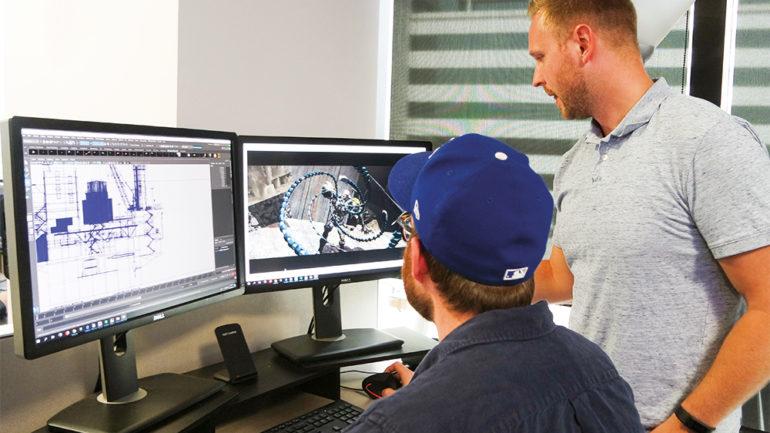How Previsualization Helps Create Pitches for Projects Like ‘Alita: Battle Angel’
By S.D. Katz
LOS ANGELES (Variety.com) – Filmmakers are increasingly using previsualization, a now-standard technique for planning highly technical shots and sequences, as a tool for pitching a project to production companies, investors and studio executives — before a single full scene has actually been shot.
More creatives are relying on the technique, dubbed “pitchvis,” to fashion a compelling and engaging presentation to get a studio to greenlight a project, such as the recent James Cameron-produced anime adaptation “Alita: Battle Angel.”
“This was a new IP for film, different from properties the filmmakers had previously done,” says Austin Bonang, senior visualization supervisor at previs provider The Third Floor. “They wanted to demonstrate how a highly stylized IP could go more into real-world visuals, including CG characters in digital worlds like ‘Avatar,’ with ‘Avatar’-like techniques, but different and unique.”
Cameron, director Robert Rodriguez and producer John Landau brought in other key members of the creative team to further demonstrate their ideas for the project. “We had lines recorded by the lead actress, Rosa Salazar, that she redubbed so that the pitchvis edit featured her actual voice, and the shots for the presentation were cut together by the film’s editor, Stephen Rivkin,” says Bonang. The previsualization pitch was then presented as part of an overall package for Fox that included a story reel and concept art.
The pitchvis took six to eight weeks to produce, which Bonang says is typical, and earned a greenlight for the movie, which was released Feb. 14 and earned $405 million worldwide.
“Alita” producer Jon Landau (“Titanic,” “Avatar”) understands the value of pitchvis, but points out that pitching is the secondary goal of the technology. “It’s about defining the creative vocabulary, the result of which we can then pitch,” he says. “It was not a presentation apart from the movie. The shots in the pitchvis were the shots in the final movie.”
The trend highlights previs studios’ role as idea factories and test labs for the entertainment industry. No part of the moviemaking process is left untouched, including showing the packages to test audiences. This has been a standard practice for decades in feature animation, where story reels similar to previs are used to screen and refine a project before beginning expensive and labor-intensive animation.
Previs is technology-driven and evolving toward greater sophistication, including the ability to create virtual-reality and augmented-reality worlds. Thus, pitchvis allows writers and directors to turn their imaginations inside out and digitally spitball eye candy for studios to choose from.
The technique also can provide proof of concept for a core story decision or stylistic choice before a movie has been greenlit. For “World War Z,” Halon helped director Marc Forster prototype a new kind of high-speed zombie. The test also was instrumental in deciding one week before shooting began to ditch the original idea of using actors in makeup and go with digital versions of the undead.
Bonang says the technique is showing a wide range of uses: “everything from pitching a director’s stylistic take on a film to exploring the world of a new concept or visualizing potential entertainment for a variety of markets.”
Using visual sales materials to get a greenlight for a movie is hardly a new practice. In the ’80s, it was common for posters to pitch a film; in the ’90s, pre-
trailers were the fashion. In the 2000s, digital production, combined with the ease of pilfering imagery online, led to “rip-o-matics” — trailers built from pieces of existing movies. But for those with a budget, pitchvis is the current go-to solution.
While pitchvis is mainly about sales, the technique provides another advantage: engagement. By putting the creative aspects of a project front and center, producers are able to connect the director with studio execs in a safe place underwritten by the producer and free to the studio that lets them fine-tune key aspects of production — until there’s a greenlight.
The cost of pitchvis during the high-risk money-raising phase of a movie, with no guarantee of a greenlight, leads to a paradox: While previsualization is created for professionals who can understand a less-detailed presentation, pitchvis is often shown to studio execs or investors who require a nearly finished film to make a decision. This forces producers to spend more upfront to get a movie underway.
Previs and pitchvis are normally thought of as being affordable only to those with blockbuster budgets, but Josh Wassung, creative director at The Third Floor, says otherwise. “Visualizing a pitch can be done in many ways, across numerous budgets and time frames,” he says. “Sometimes a verbal pitch with storyboards is ideal. Sometimes large VFX-heavy sequences need to be visualized with nuanced detail. Pitchvis covers both and everything in between.”
For Landau, the overall value of pitchvis is in quickly providing a more fully realized product that can be shown to studio execs and others. “The more imagery you can put into someone’s mind,” he says, “the better their imagination is in sync with your vision of the movie you want to make.”

